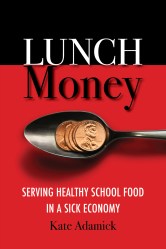
Kate Adamick thinks changing school lunch is as easy as changing the way cafeterias spend money.
Kate Adamick is a firm believer in the old saying, “A penny saved is a penny earned.” A food systems consultant and co-founder of Cook for America, she has put the adage to work in hundreds of school districts nationwide through her Lunch Teachers culinary boot camps. In these weeklong workshops, Adamick teaches food service staff how to most efficiently manage their limited budgets — to the penny — toward providing students with freshly prepared, whole foods-based meals.
Adamick’s new book, Lunch Money: Serving Healthy School Food in a Sick Economy, captures those strategies in print, from capitalizing on commodity food products to generating additional revenue from a breakfast-in-the-classroom program. It’s likely to make a valuable read for school food service directors working to revamp menus in accordance with the U.S. Department of Agriculture’s new school rules and determining how best to utilize an additional subsidy of 6 cents per meal. But Adamick’s clear reiteration of the importance of a better school lunch now also makes the book worthwhile for school food reformers, teachers, parents, and anyone who cares about what kids eat at school.
I spoke with Adamick recently about her new book, the new federal school lunch rules, chocolate milk, and the role of “lunch ladies” in all this. Below is an excerpt of our conversation.
Q. You’ve worked as a corporate attorney, a chef in a four-star French restaurant, and you’ve owned a large wholesale and retail bakery. Why did school lunch become important to you?
A. Obviously, I change careers more often than some people change their clothes. About 10 years ago, I had just sold my bakery business when a friend asked me, “What are you going to do when you grow up this time?” When she asked, I had just finished reading one of the early reports about the rising rates of childhood obesity in America. I decided then and there that I wanted to do something about it. School food turned out to be — at least for me — the clearest route for effecting positive change in the lives of as many children as possible.
Q. What are your thoughts on the USDA’s new federal nutrition standards, i.e. increased servings of fruits, vegetables, and whole grain-rich foods; healthier milk offerings; and sodium and calorie limits?
A. The new USDA regulations are a good start, but only a start. I am disappointed — though, sadly, not surprised — that our government chose the interests of corporate America over the interests of our children by requiring the reduction of sodium in school meals gradually over 10 years (rather than more quickly, as recommended by the Institute of Medicine) because industry needs time for product development and testing. I was also dismayed by the regulations’ failure to limit the sugar content in school meals. On the other hand, for the first time, the regulations place a maximum limit on the number of calories that can be served — a critical step to addressing the childhood obesity issue.
Q. Schools complying with these new standards are eligible for an additional subsidy of 6 cents per meal. Even with this increased funding, food service directors may have little more than $1 to spend on food per meal. Given such tight budgets, many people believe that providing students with fresh, whole foods-based meals prepared from scratch is cost-prohibitive. In your book, you call this belief a myth. Say more.
A. For many years I was no different than every other school food reform activist calling for increased federal funding. When the economy began tanking in 2008, I realized that would be unlikely. It was then that I started looking at the financial operations of school food service departments with a critical eye. I hoped that I would be able to use my own culinary experience, along with all of the knowledge I gained while minoring in accounting, to identify lost revenue and wasted money in the status quo for school food. It turned out not to be difficult; and that’s good news. Nearly every school district can find ways to eliminate unnecessary expenses and/or improve its revenue stream while also serving healthier food to its students. So, while other school food reform advocates are proclaiming the 6-cent increase insufficient, I believe that is not even necessary for most school districts — especially when we can be fairly certain that the manufacturers of the processed junk that passes for food will simply raise their prices to ensure that those 6 cents end up in their pockets.
Q. There appear to be quite a few equations and worksheets in the book. You’re challenging your readers’ mathematical skills too?
A. The worksheets are there so that readers’ math skills don’t have to be challenged. While they may appear intimidating, they are actually quite easy. I like to think that if the IRS tax forms were this simple, H&R Block would be out of business. I put the worksheets in the book for two reasons. One was to demystify the math. The second is because seeing is believing. When you go through the steps you see that thousands, tens of thousands, hundreds of thousands, and millions of dollars can be saved across the district during the school year.
Q. What is the significance of your discussion of Laura Ingalls Wilder’s Little House in the Big Woods in Lunch Money?
A. Little House in the Big Woods is essentially the story of a post-Civil War era family feeding itself over the course of a year in the wilderness. They hunted, foraged, and grew virtually all of their own food, and “store-bought” food was rare.
One of the ways school districts can save money is by no longer serving dessert with school meals. Not only will removing dessert from school menus help improve the overall quality of the meals, but the money saved can be used to help pay for more fresh produce and higher quality protein. Moreover, limiting the number of times a year that dessert is served in school will be a reminder that [dessert], while not forbidden, is to be eaten on special occasions, rather than as daily fare.
Q. You also encourage schools to offer breakfast in the classroom (BIC), stating that a such a program can provide a “meaningful financial boost” to schools. How so?
A. The benefits of eating before undertaking difficult intellectual challenges haven’t escaped the notice of many educators, who often request that breakfast be served in their classrooms on state aptitude testing days. Of course, if students score higher when they are fed properly before taking a test, they will test higher still if fed when they are learning the materials.
Because federal funding for the school breakfast program in Severe Needs schools [PDF] is considerably higher than the funding in more affluent schools, and due to the relatively low cost of food served at breakfast (when compared to lunch), a BIC program can give a meaningful financial boost to such schools [through federal reimbursement revenue].
The trick, though, is to capture all of the federal reimbursement dollars by serving breakfast to all of the students, which is most easily accomplished by feeding them during the first 10 minutes of the day. I have even had the pleasure of watching a classroom of young students say the pledge of allegiance with their right hands held over their hearts and while their left hands held bananas.
Q. How does the role of “lunch ladies,” cooks, kitchen managers, etc., need to change to improve school lunch?
A. It’s critical that the school food work environment and workforce be professionalized. Sadly, food service workers, who have the opportunity to save our students’ lives, are typically treated as the least important. Foremost among Cook for America’s goals is to build food service workers’ confidence, motivation, culinary skills, and awareness of food systems issues. The graduates of our culinary boot camps are recognized as ambassadors who lead the school food reform movement in their own districts and embrace their essential role in teaching children about the pleasures and benefits of eating real food prepared in a healthful manner.
Q. Food service management companies, such as Aramark and Sodexo, operate the school lunch programs of many districts. Can schools apply the same strategies that you outline in your book while working with these companies?
A. My personal belief is that food service management companies have no place in public schools. I have yet to come across a school food service staff that isn’t capable of preparing affordable and healthy, scratch-cooked meals using fresh, whole foods if given the proper training. All too often, food service management companies come into a school district and slash staff hours and benefits, while reducing the quality of the school food so as to maximize profits for themselves. Better to empower your existing food service workers — who are often your friends and neighbors — to do their jobs better than to bring in outsiders who have a built-in financial incentive to maximize their own profits.
Q. You’ve said, “School food is the solution, not the problem!” Should we be optimistic?
A. Absolutely. Nearly every child in America eats at least one meal a day at school nearly half the days of the year. That gives us a captive audience, not only to feed them in a healthful manner, but to teach them how to feed themselves. Our challenge as a nation is to commit ourselves to take advantage of that opportunity. The good news is that it can be done by the people who are already working in our school cafeterias and within the budget that they currently have at their disposal. All they need is training, and our admiration and support.




